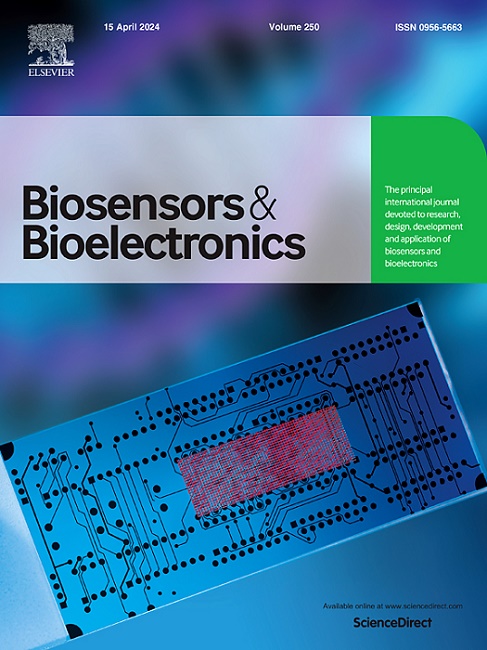High-fidelity optical platform for multiplex glutathione profiling links redox dynamics to tumor progression and auxiliary diagnosis
IF 10.5
1区 生物学
Q1 BIOPHYSICS
引用次数: 0
Abstract
Gastric cancer, a leading global cause of tumor-related mortality, demands potent biomarkers and robust analytical technologies to reduce the clinical burden. Here, a dual-mode ratiometric optical sensor paired with a portable smartphone-based reader was developed for glutathione (GSH). This work reveals, for the first time, the molecular mechanism behind the responsibility and selectivity of tetraphenylporphyrin tetrasulfonic acid (TPPS) to GSH. This high-fidelity character eliminates cross-interference from competing thiols and mitigates the inherent susceptibility of TPPS to transition metals by strategic masking agents. The sensor exhibits a dose-sensitive response to GSH from 0 to 200 μM with a limit of detection (LOD) of 0.75 μM. Following validation with pharmaceutical samples and cellular assays, the platform was translated into clinical research for tumor progression and auxiliary diagnosis. By cohorts of gastric cancer and health control, a multivariate model linking clinical signatures with GSH levels was established, which reveals significant correlations between GSH and tumor size, tumor infiltration, and nutritional status. Further developed diagnostic model combining GSH and pepsinogen II (PGII) yielded an area under the curve (AUC) of 0.986 for distinguishing cancer patients from healthy controls. These studies highlight applicability of GSH-based optical sensing in precision oncology for clinical management of gastric cancer.
高保真光学平台多重谷胱甘肽分析链接氧化还原动力学肿瘤进展和辅助诊断
胃癌是全球肿瘤相关死亡的主要原因,需要有效的生物标志物和强大的分析技术来减轻临床负担。本研究开发了一种用于谷胱甘肽(GSH)的双模比例光学传感器,该传感器与便携式智能手机阅读器配对。这项工作首次揭示了四苯基卟啉四磺酸(TPPS)对谷胱甘肽的作用和选择性的分子机制。这种高保真特性消除了来自竞争硫醇的交叉干扰,并通过策略掩蔽剂减轻了TPPS对过渡金属的固有敏感性。该传感器对GSH的响应范围为0 ~ 200 μM,检测限(LOD)为0.75 μM。经过药物样品和细胞分析的验证,该平台被转化为肿瘤进展和辅助诊断的临床研究。通过胃癌和健康对照的队列,建立了临床特征与GSH水平的多变量关联模型,发现GSH与肿瘤大小、肿瘤浸润和营养状况之间存在显著相关性。进一步建立的GSH和胃蛋白酶原II (PGII)联合诊断模型在区分癌症患者和健康对照方面的曲线下面积(AUC)为0.986。这些研究突出了基于谷胱甘肽的光学传感在精确肿瘤学中对胃癌临床管理的适用性。
本文章由计算机程序翻译,如有差异,请以英文原文为准。
求助全文
约1分钟内获得全文
求助全文
来源期刊

Biosensors and Bioelectronics
工程技术-电化学
CiteScore
20.80
自引率
7.10%
发文量
1006
审稿时长
29 days
期刊介绍:
Biosensors & Bioelectronics, along with its open access companion journal Biosensors & Bioelectronics: X, is the leading international publication in the field of biosensors and bioelectronics. It covers research, design, development, and application of biosensors, which are analytical devices incorporating biological materials with physicochemical transducers. These devices, including sensors, DNA chips, electronic noses, and lab-on-a-chip, produce digital signals proportional to specific analytes. Examples include immunosensors and enzyme-based biosensors, applied in various fields such as medicine, environmental monitoring, and food industry. The journal also focuses on molecular and supramolecular structures for enhancing device performance.
 求助内容:
求助内容: 应助结果提醒方式:
应助结果提醒方式:


